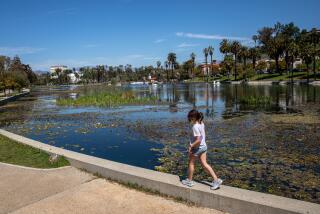Ocean Site Reportedly Used for Toxics Dump
A 28-square-mile area off Santa Catalina Island served as a toxic waste dump with government knowledge for 20 years, and several scientists say it might be the worst such mess in history, Los Angeles television station KCBS reported Wednesday.
Dr. Rimmon Fay, an independent Venice marine biologist, said the disclosures show that fish contamination in Santa Monica Bay can be attributed to more than just the DDT-containing sewage that flowed through the White’s Point outfall on the Palos Verdes Peninsula coast from a firm that once manufactured the now-banned pesticide.
“I had known there was a dump site there,” Fay said of the island area, “but none of us knew before this story broke of the quantities or the nature of what was dumped out there. The water pollution is far more severe than any of us had any idea of. . . . It’s a scary situation.”
Dr. Robert Risebrough, a marine biologist at the University of California, Santa Cruz, called it “the worst case of pollution that we know of.”
KCBS said it based its report on government documents proving that for two decades beginning in 1947, such agencies as the Southern California Regional Water Quality Control Board were aware of and approved of the dumping by private companies of large quantities of toxic wastes. These purportedly included beryllium, a suspected carcinogen; formaldehyde; napalm, cyanide and “tens of thousands of pounds of acid, solvents and pathology wastes that were never identified.”
Field reports from the Environmental Protection Agency revealed that dump crews punctured the barrels with axes to make certain they would sink, KCBS said.
In one two-year period, in 1957 and 1958, according to the report, almost 2 million gallons of sludge “laced with DDT” made by the Montrose Chemical Co. were dumped from barges in the ocean nearly 20 miles north of the island’s west end. Montrose formerly operated a plant on Normandie Avenue near Del Amo Boulevard that was the largest manufacturer of DDT in the world. The plant site is still being cleaned up and is on the federal Superfund list of toxic waste sites needing immediate attention.
Current staff members of the Regional Water Quality Control Board were not available for comment Wednesday evening. Nor was Raymond M. Hertel, who served as the agency’s executive officer for many years.
More to Read
Sign up for Essential California
The most important California stories and recommendations in your inbox every morning.
You may occasionally receive promotional content from the Los Angeles Times.









